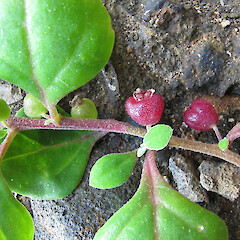Tetragonia trigyna
Common name
native spinach
Synonyms
Tetragonia implexicoma var. chathamica F.Muell.,
Family
Aizoaceae
Flora category
Vascular – Native
Endemic taxon
No
Endemic genus
No
Endemic family
No
Structural class
Lianes & Related Trailing Plants - Dicotyledons
NVS code
The National Vegetation Survey (NVS) Databank is a physical archive and electronic databank containing records of over 94,000 vegetation survey plots - including data from over 19,000 permanent plots. NVS maintains a standard set of species code abbreviations that correspond to standard scientific plant names from the Ngä Tipu o Aotearoa - New Zealand Plants database.
TETIMP
Chromosome number
2n = 32
Current conservation status
The conservation status of all known New Zealand vascular plant taxa at the rank of species and below were reassessed in 2017 using the New Zealand Threat Classification System (NZTCS) – more information about this can be found on the NZTCS website. This report includes a statistical summary and brief notes on changes since 2012 and replaces all previous NZTCS lists for vascular plants.
Please note, threat classifications are often suggested by authors when publications fall between NZTCS assessment periods – an interim threat classification status has not been assessed by the NZTCS panel.
- Conservation status of New Zealand indigenous vascular plants, 2017 . 2018. Peter J. de Lange, Jeremy R. Rolfe, John W. Barkla, Shannel P. Courtney, Paul D. Champion, Leon R. Perrie, Sarah M. Beadel, Kerry A. Ford, Ilse Breitwieser, Ines Schönberger, Rowan Hindmarsh-Walls, Peter B. Heenan and Kate Ladley. Department of Conservation. Source: NZTCS and licensed by DOC for reuse under the Creative Commons Attribution 4.0 International licence.
2017 | Not Threatened | Qualifiers: SO
Previous conservation statuses
2012 | Not Threatened
2009 | Not Threatened
2004 | Not Threatened
Distribution
Indigenous. New Zealand: Kermadec Islands (Herald Islets, Raoul, Macauley Islands), Three Kings, North, South and Chatham Islands. Also Norfolk and Lord Howe Islands.
Habitat
Coastal to montane. Mostly found in coastal areas occupying a variety of habitats from cobble and sand beaches through coastal forest and shrubland, also found in exposed windshorn vegetation on cliffs and rock stacks. Occasionally found growing well inland, sometimes in farmland where it grows in barberry (Berberis spp.) hedges or on limestone and calcareous sandstone outcrops in otherwise dense forest.
Detailed description
Prostrate or scrambling subshrub forming straggling to dense leafy patches up to 4 m long. Stems long trailing, terete, initially somewhat succulent, and often coloured red or pink, maturing dark green to brown-black and becoming woody with age. Leaves alternate, often clustered, sometimes widely spaced along stems, fleshy, papillose; petiole 3-15(-20) mm long; lamina 20-50(-80) × (8-)10-30(-46) mm, ovate-rhomboid to lanceolate, to linear-lanceolate, adaxially dark green, green to almost glaucescent, abaxially paler, sometimes flushed pink. Flowers solitary; pedicels slender, 5-30 mm long. Perianth lobes 4, (1.8-)2.8-3.0(-3.6) mm long, oblong, abaxially papillose-hairy, adaxially finely papillose, yellow. Stamens 12-20. Ovary semi-inferior; locules and styles 2(-3). Fruit 5-8 mm long, succulent, pink to dark red, subglobose.
Similar taxa
Tetragonia trigyna is only ever likely to be confused with the related T. tetragonoides (New Zealand spinach) from which it is most reliably distinguished when fruiting by the pink to dark red fleshy, subglobose fruits rather than the dry, leathery obconic and distinctly horned fruits typical of T. tetragonoides.
Flowering
September - June
Flower colours
Yellow
Fruiting
September - July
Propagation technique
Easily grown from rooted pieces, stem cuttings and from fresh fruit. Although edible, Tetragonia trigyna has a decidedly less agreeable, more “soapy” taste. Like T. tetragonoides this species flourishes in a rich soil and does best grown in full sun. It can be used as a very effective ground cover in coastal situations and can be trained up walls and down cliff faces. It is reasonably drought tolerant but will not stand much frost. In New Zealand the species is highly variable and some populations, notably those from the Kermadec and Three Kings Islands have rather small leaves and a more compact growth habit which might be worth utilizing in cultivation.
Threats
Not Threatened. A widespread and common species throughout most of coastal New Zealand.
Etymology
tetragonia: Four-angled
Attribution
Fact sheet prepared for NZPCN by P.J. de Lange 24 October 2011. Description by P.J. de Lange.
NZPCN Fact Sheet citation
Please cite as: de Lange, P.J. (Year at time of access): Tetragonia trigyna Fact Sheet (content continuously updated). New Zealand Plant Conservation Network. https://www.nzpcn.org.nz/flora/species/tetragonia-trigyna/ (Date website was queried)














